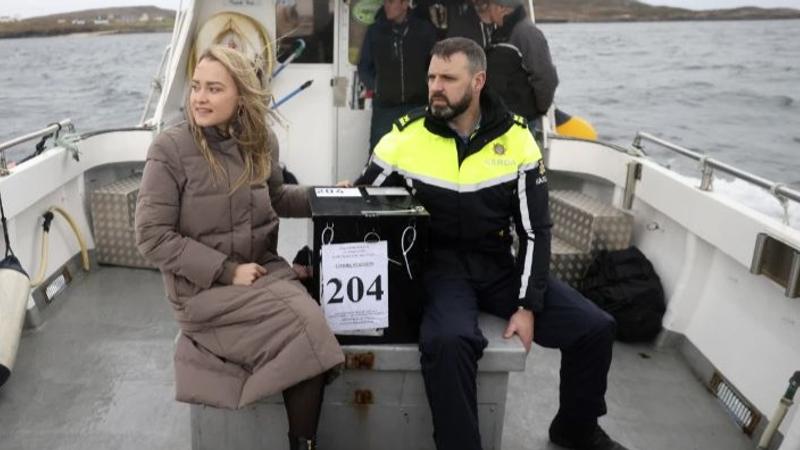Published 07:28 IST, November 30th 2024
Ireland Headed for Coalition Government Following Parliamentary Election, Exit Poll Suggests
Pollster Ipsos B&A asked 5,018 voters across the country how they had cast their ballots.

Advertisement
Dublin: An exit poll in Ireland's parliamentary election released late Friday suggests the three biggest parties have won roughly equal shares and the country is headed for another coalition government.
A poll released as voting ended at 10 pm (2200 GMT) said centre-right party Fine Gael was the first choice of 21 per cent of voters, with its centre-right coalition partner Fianna Fail at 19.5 per cent. Left-of-centre opposition Sinn Fein was at 21.1 per cent in the poll.
Pollster Ipsos B&A asked 5,018 voters across the country how they had cast their ballots. The survey has a margin of error of plus or minus 1.4 percentage points.
The figures only give an indication and don't reveal which parties will form the next government. Counting of ballots starts Saturday morning and it will take between several hours and several days for full results to be known.
The result will show whether Ireland bucks the global trend of incumbents being ousted by disgruntled voters after years of pandemic, international instability and a cost-of-living pressures.
Though Sinn Fein, which aims to reunite Northern Ireland with the independent Republic of Ireland, could become the largest party in the 174-seat Dail, the lower house of parliament, it may struggle to get enough coalition partners to form a government. Both Fine Gael and Fianna Fail have refused to form alliances with it.
Here's a look at the parties, the issues and the likely outcome.
Who's running? The outgoing government was led by the two parties who have dominated Irish politics for the past century: Fine Gael and Fianna Fail. They have similar centre-right policies but are longtime rivals with origins on opposing sides of Ireland's 1920s civil war.
After the 2020 election ended in a virtual dead heat they formed a coalition, agreeing to share Cabinet posts and take turns as taoiseach, or prime minister. Fianna Fail leader Micheál Martin served as premier for the first half of the term and was replaced by Fine Gael's Leo Varadkar in December 2022. Varadkar unexpectedly stepped down in March, passing the job to current Taoiseach Simon Harris.
Opposition party Sinn Fein achieved a stunning breakthrough in the 2020 election, topping the popular vote, but was shut out of government because Fianna Fail and Fine Gael refused to work with it, citing its leftist policies and historic ties with militant group the Irish Republican Army during three decades of violence in Northern Ireland.
Under Ireland's system of proportional representation, each of the 43 constituencies elects multiple lawmakers, with voters ranking their preferences. That makes it relatively easy for smaller parties and independent candidates with a strong local following to gain seats.
This election includes a large crop of independent candidates, ranging from local campaigners to far-right activists and reputed crime boss Gerry “the Monk” Hutch.
What are the main issues? As in many other countries, the cost of living — especially housing — has dominated the campaign. Ireland has an acute housing shortage, the legacy of failing to build enough new homes during the country's “Celtic Tiger” boom years and the economic slump that followed the 2008 global financial crisis.
“There was not building during the crisis, and when the crisis receded, offices and hotels were built first,” said John-Mark McCafferty, chief executive of housing and homelessness charity Threshold.
The result is soaring house prices, rising rents and growing homelessness.
After a decade of economic growth, McCafferty said “Ireland has resources” — not least 13 billion euros ($13.6 billion) in back taxes the European Union has ordered Apple to pay it — “but it is trying to address big historic infrastructural deficits.” Tangled up with the housing issue is immigration, a fairly recent challenge to a country long defined by emigration. Recent arrivals include more than 100,000 Ukrainians displaced by war and thousands of people fleeing poverty and conflict in the Middle East and Africa.
This country of 5.4 million has struggled to house all the asylum-seekers, leading to tent camps and makeshift accommodation centres that have attracted tension and protests. A stabbing attack on children outside a Dublin school a year ago, in which an Algerian man has been charged, sparked the worst rioting Ireland had seen in decades.
Unlike many European countries, Ireland does not have a significant far-right party, but far-right voices on social media seek to drum up hostility to migrants, and anti-immigrant independent candidates are hoping for election in several districts. The issue appears to be hitting support for Sinn Fein, as working-class supporters bristled at its pro-immigration policies.
What's the likely outcome? The exit poll bears out earlier opinion polls findings that voters' support is split widely among Fine Gael, Fianna Fail, Sinn Fein, several smaller parties and an assortment of independents.
Before polling day, analysts said the most likely outcome is another Fine Gael-Fianna Fail coalition, possibly with a smaller party or a clutch of independents as kingmakers. That remains the most likely option.
“It's just a question of which minor group is going to be the group that supports the government this time,” said Eoin O'Malley, a political scientist at Dublin City University. “Coalition-forming is about putting a hue on what is essentially the same middle-of-the-road government every time.”
Updated 07:28 IST, November 30th 2024




